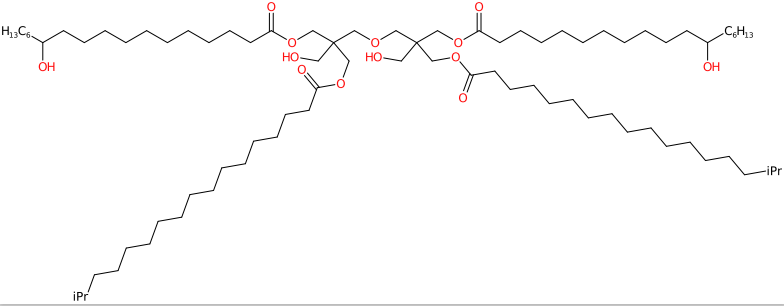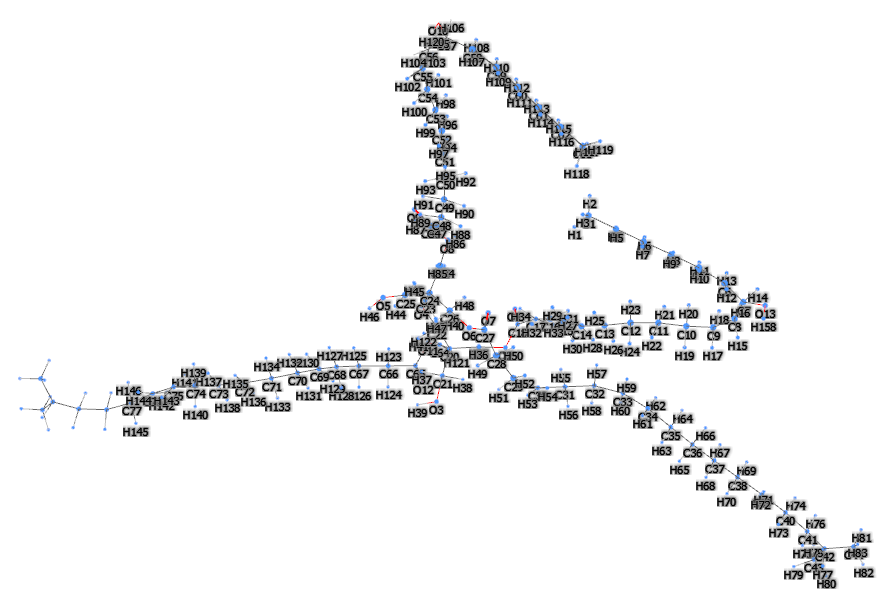Dipentaerythrityl tetrahydroxystearate/tetraisostearate is a high molecular weight chemical compound, a tetraester of dipentaerythritol and hydroxystearic acid/isostearic acid.
The name describes the structure of the molecule:
- Dipentaerythrityl indicates that the molecule is derived from pentaerythritol, a type of polyol, and that two pentaerythritol molecules are involved in the formation of the compound.
- Tetrahydroxystearate/Tetraisostearate indicates that the molecule contains four hydroxystearate or isostearate groups. Hydroxystearate is a derivative of stearic acid, a type of fatty acid, to which a hydroxyl group (-OH) has been added. Isostearate is a branched version of stearic acid.
The synthesis process takes place in different steps:
- Preparation of pentaerythritol and stearic acid. Pentaerythritol is synthesised from acetaldehyde and formaldehyde in the presence of an alkaline catalyst. Stearic acid is typically derived from fats and oils through the saponification of triglycerides.
- Esterification. Pentaerythritol and stearic acid are reacted in a process called esterification. This involves the formation of an ester bond between the alcohol group of pentaerythritol and the carboxylic acid group of stearic acid, forming Dipentaerythrityl Tetrahydroxystearate/Tetraisostearate.
What it is for and where
Farmaceutical
Skin conditioning agent, hydrophobic, has the capacity to retain water, thanks to the presence of hydroxyl groups in the molecule. It is generally used as a substitute for lanolin.
Cosmetics
It is included in personal care formulations and particularly in skin care as a viscosity control agent in lipsticks, creams and skin lotions.
Skin conditioning agent. It is the mainstay of topical skin treatment as it has the function of restoring, increasing or improving skin tolerance to external factors, including melanocyte tolerance. The most important function of the conditioning agent is to prevent skin dehydration, but the subject is rather complex and involves emollients and humectants that can be added in the formulation.
Viscosity control agent. It controls and adapts viscosity to the required level for optimal chemical and physical stability of the product and dosage in gels, suspensions, emulsions, solutions.
| Appearance | White powder |
| PSA | 195.35000 |
| LogP | 21.83260 |
- Molecular Formula C82H158O13
- Molecular Weight 1352.1
- Exact Mass 1351.17000
- CAS 220716-33-6
- UNII 230K0823CE
- EC Number 928-040-2
- DSSTox Substance ID
- IUPAC [2-(hydroxymethyl)-2-[[2-(hydroxymethyl)-2-(12-hydroxyoctadecanoyloxymethyl)-3-(16-methylheptadecanoyloxy)propoxy]methyl]-3-(16-methylheptadecanoyloxy)propyl] 12-hydroxyoctadecanoate
- InChI=1S/C82H158O13/c1-7-9-11-47-57-75(85)59-49-39-31-25-27-35-43-53-63-79(89)94-71-81(65-83,69-92-77(87)61-51-41-33-23-19-15-13-17-21-29-37-45-55-73(3)4)67-91-68-82(66-84,70-93-78(88)62-52-42-34-24-20-16-14-18-22-30-38-46-56-74(5)6)72-95-80(90)64-54-44-36-28-26-32-40-50-60-76(86)58-48-12-10-8-2/h73-76,83-86H,7-72H2,1-6H3
- InChl Key VAKUGTCMNBMGQU-UHFFFAOYSA-N
- SMILES CCCCCCC(CCCCCCCCCCC(=O)OCC(CO)(COCC(CO)(COC(=O)CCCCCCCCCCCCCCC(C)C)COC(=O)CCCCCCCCCCC(CCCCCC)O)COC(=O)CCCCCCCCCCCCCCC(C)C)O
- MDL number
- PubChem Substance ID
Synonyms:
Pelemol DP-72
Salacos 168 EV
Cosmol 168 EV



